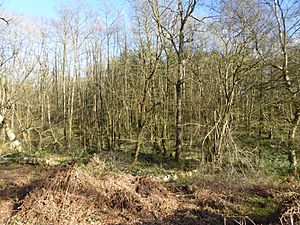Enborne Copse facts for kids
| Site of Special Scientific Interest | |
 |
|
| Area of Search | Berkshire |
|---|---|
| Interest | Biological |
| Area | 11.9 hectares (29 acres) |
| Notification | 1985 |
| Location map | Magic Map |
Enborne Copse is a special woodland area in Berkshire, England. It's located west of Newbury. This place is known as a Site of Special Scientific Interest (SSSI). This means it's protected because it has important plants, animals, or geology. Enborne Copse covers about 11.9 hectares (29 acres), which is like 30 football fields! It's also recognized as a Nature Conservation Review site, highlighting its importance for wildlife.
Contents
History of Enborne Copse
The shape of Enborne Copse hasn't changed much over hundreds of years. Maps from 1761, made by John Rocque, show the woodland looking almost the same as it does today.
However, most of the original woodland has changed. It was turned into a plantation with conifer trees. Only the part that is now a Site of Special Scientific Interest (SSSI) still has its natural broad-leaved trees. These are the kinds of trees that lose their leaves in autumn.
Amazing Plants of Enborne Copse
Enborne Copse is home to many different types of plants. These plants are important for the woodland's ecosystem. They provide food and shelter for animals.
Trees in the Woodland
The woodland has a variety of trees. These include both tall trees and smaller, bush-like ones.
- Betula pubescens (Downy Birch)
- Fraxinus (Ash)
- Tilia cordata (Small-leaved Lime)
- Quercus robur (English Oak)
- Hazel
- Alder
- Salix caprea (Goat Willow)
- Viburnum opulus (Guelder-rose)
- Sorbus aucuparia (Rowan)
- Sambucus nigra (Elder)
- Frangula alnus (Alder Buckthorn)
- Malus sylvestris (Crab Apple)
- Quercus cerris (Turkey Oak)
Other Plants and Flowers
Besides the trees, many smaller plants and flowers grow on the woodland floor. Some of these are quite rare or special.
- Convallaria majalis (Lily of the Valley)
- Primula vulgaris (Primrose)
- Polygonatum multiflorum (Solomon's Seal)
- Euphorbia amygdaloides (Wood Spurge)
- Lamium galeobdolon (Yellow Archangel)
- Hyacinthoides non-scripta (Bluebell)
- Oxalis (Wood Sorrel)

